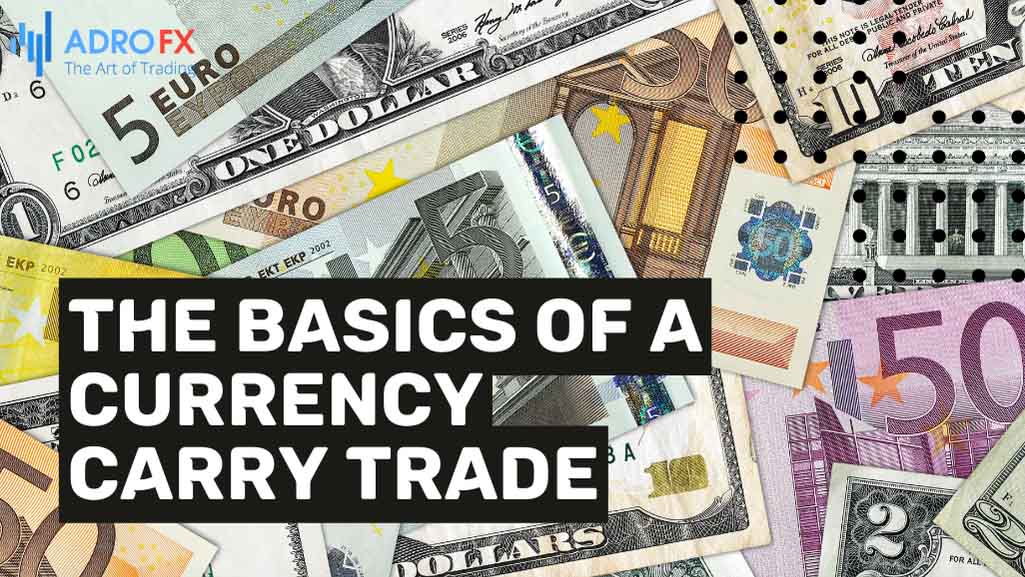Currency Carry Trading: Leveraging Interest Rates for Profitable Trades

Currency carry trading involves taking long positions in currencies with higher interest rates while simultaneously shorting currencies with lower interest rates, aiming to profit from interest rate differentials. However, this strategy carries the risk of capital loss if forex pair prices move unfavorably. Factors such as global interest rates, market volatility, and currency-specific risks are critical in determining the profitability of carry trades. Implementing risk management strategies like Stop Losses is essential to mitigate potential losses.
Currency carry trades capitalize on variations in interest rates between different countries, utilizing the spot forex market and its CFD equivalents as ideal platforms for execution.
Now, let's explore the intricacies of currency carry trades further.
What Exactly is a Currency Carry Trade?
A carry trade involves taking a long position in one currency to benefit from its higher interest rate while simultaneously shorting another currency with a lower interest rate, allowing the trader to profit from the interest rate differential.
Mechanically, initiating a currency carry trade resembles executing any other forex trade - establishing long or short positions on Forex pairs, primarily based on interest rate differentials.
If this concept seems daunting, let's simplify it further.

The Basics of a Currency Carry Trade
Understanding the fundamentals of a currency carry trade involves breaking it down into essential components:
Interest Rate Differential
The core of a currency carry trade lies in the interest rate differential between two currencies. Traders exploit this difference by borrowing or selling a currency with a low interest rate and using the proceeds to invest in or buy a currency with a higher interest rate.
Long and Short Positions
In currency carry trades, traders typically take a long position in the currency with the higher interest rate and a short position in the currency with the lower interest rate. This allows them to earn interest income from the long position while paying less interest on the short position, thus profiting from the interest rate differential.
Financing and Rollover Costs
It's crucial to consider financing and rollover costs associated with maintaining carry trade positions. These costs may diminish potential profits and should be factored into the overall trade strategy.
Market Volatility and Risk
Currency carry trades are not risk-free. Exchange rate fluctuations can erode potential gains or lead to losses, particularly if the market moves against the trader's positions. Additionally, unforeseen events such as economic crises or geopolitical tensions can increase market volatility, amplifying the risks associated with carry trades.
Risk Management
Given the inherent risks, effective risk management is vital when engaging in currency carry trades. Traders may utilize various risk mitigation strategies such as setting Stop Loss orders, diversifying their portfolio, or using leverage cautiously to limit potential losses.
By grasping these basic principles, traders can confidently navigate the complexities of currency carry trades and make informed decisions to enhance profitability while effectively managing risks.
Currency Carry Trade Example
Let's illustrate the concept of a currency carry trade with a hypothetical example.
Suppose a trader identifies the USD/JPY currency pair, where the base currency (USD) now has a higher interest rate of 5.5%, while the quote currency (JPY) maintains an interest rate of 0.1% (as in the previous example).
- Interest Rate Differential
With the new interest rates, the interest rate differential becomes 5.4% (5.5% - 0.1%). - Long and Short Positions
The trader decides to go long on USD/JPY, purchasing US dollars and simultaneously selling Japanese yen. The goal remains the same: to earn interest on the US dollars while paying a lower interest rate on the borrowed Japanese yen. - Trade Execution
Assuming the trader invests $100,000, they borrow Japanese yen equivalent to $100,000 and convert it into US dollars at the current exchange rate of 110 JPY/USD, receiving approximately 9,090,909 JPY. - Interest Income
Over the year, the trader earns interest on the US dollars at a rate of 5.5%, yielding $5,500. On the borrowed Japanese yen, they pay interest at a rate of 0.1%, totaling approximately 10,000 JPY. - Net Profit
At the end of the year, the trader closes the trade. They repay the borrowed Japanese yen, amounting to approximately 9,100,000 JPY (initial principal plus interest). Converting the remaining US dollars back to the Japanese yen at the exchange rate of 108 JPY/USD, they receive approximately 9,090,909 JPY. - Calculating the Profit
The trader's net profit from the carry trade is the difference between the interest earned on the US dollars and the interest paid on the borrowed Japanese yen, minus any financing and transaction costs.
This simplified example demonstrates how a currency carry trade can potentially generate profits for traders by capitalizing on interest rate differentials between currencies. However, it's important to remember that actual trade outcomes may vary due to factors such as exchange rate fluctuations, interest rate changes, and market conditions. Therefore, careful analysis and risk management are essential when executing carry trades.

Advantages and Drawbacks of Currency Carry Trading
Engaging in currency carry trading opens doors to both enticing opportunities and daunting risks for traders. Let's delve into the advantages and disadvantages:
Upsides
- Profit Potential
A primary allure of currency carry trading lies in the promising potential for profit fueled by interest rate differentials. Leveraging low-interest-rate currencies for borrowing while investing in high-interest-rate currencies enables traders to net positive carry, yielding returns over time. - Portfolio Diversification
Currency carry trading facilitates portfolio diversification, extending beyond conventional assets like stocks and bonds. This diversification strategy aids in risk distribution, potentially amplifying overall portfolio returns. - Market Liquidity
The forex market, the primary arena for currency carry trades, boasts high liquidity. This liquidity abundance provides traders ample opportunities to initiate and exit positions without triggering significant price fluctuations, ensuring swift trade execution and mitigating slippage. - Accessibility:
The forex market operates around the clock, five days a week, offering traders flexibility in executing carry trades. Moreover, advancements in technology have democratized market access, empowering retail traders to partake in forex trading via user-friendly online platforms.
Downsides
- Exchange Rate Vulnerability
Currency carry trading exposes traders to exchange rate volatility, where currency fluctuations can sway trade profitability. Adverse exchange rate movements can erode potential gains or even result in losses, particularly if market dynamics work against traders' positions. - Interest Rate Uncertainty
Fluctuations in interest rates, whether anticipated or abrupt, can disrupt the profitability of currency carry trades. For instance, a central bank's interest rate hike in a currency underpinning a trader's short position can escalate borrowing costs, consequently diminishing trade profitability. - Market Volatility
The forex market's susceptibility to volatility, driven by multifarious factors such as economic data releases, geopolitical tensions, and market sentiment, poses a formidable challenge. Heightened volatility escalates the risk of unforeseen losses and complicates accurate market prognostication. - Carry Trade Unwinding
During periods of market turmoil or heightened risk aversion, investors may unravel carry trades swiftly, triggering abrupt and substantial exchange rate fluctuations. Such carry trade unwinding scenarios can inflict significant losses on traders positioned unfavorably. - Leverage Perils
While leverage holds the promise of magnifying potential returns, it simultaneously amplifies losses. Traders employing leverage in currency carry trading must exercise prudence to avoid undue losses.
In essence, currency carry trading beckons with profit potential and diversification prospects, yet it harbors inherent risks encompassing exchange rate vulnerability, interest rate uncertainty, market volatility, carry trade unwinding, and leverage perils. Traders must meticulously evaluate these factors and institute robust risk management measures to navigate the intricacies of currency carry trading effectively.
Risk Management Strategies in Carry Trading
Mitigating potential losses and preserving capital is imperative in carry trading, necessitating the implementation of effective risk management strategies. Traders employ a variety of tactics to achieve this goal:
- Stop Loss Orders
Traders commonly utilize Stop Loss orders to cap losses on carry trades. By establishing predefined exit points, positions automatically close if market movements surpass a specified threshold, curtailing further losses. - Diversification
Essential for spreading risk, diversification involves allocating capital across multiple currency pairs and asset classes. Rather than concentrating all resources in a single trade, diversifying across different markets helps cushion the impact of adverse movements in any individual position. - Market Awareness:
Staying abreast of economic events, central bank policies, and geopolitical developments is crucial. Understanding factors influencing currency markets enables traders to anticipate risks and adjust positions accordingly. - Position Sizing
Critical for risk management, prudent allocation of capital involves considering variables such as account size, risk tolerance, and currency pair volatility. Appropriately sizing positions mitigates overexposure and curtails potential losses on the overall portfolio. - Hedging Strategies:
To offset exposure to adverse market movements, traders employ hedging techniques. Hedging currency risk can involve entering offsetting positions or utilizing derivative instruments like options or futures contracts. - Discipline and Trading Plan Adherence
Maintaining discipline and adhering to a well-defined trading plan are paramount. Emotional impulses such as fear and greed can undermine strategies. Following a disciplined approach and adhering to predetermined risk management rules enhance long-term trading outcomes.
Conclusion
Currency carry trading presents enticing opportunities for capitalizing on interest rate differentials. However, it's essential to acknowledge and manage the inherent risks. Effective risk management, encompassing Stop Loss orders, diversification, market awareness, prudent position sizing, hedging, and disciplined trading, is indispensable. By comprehending carry trading fundamentals and implementing robust risk management strategies, traders can enhance profitability while navigating the complexities of the market environment. Success in carry trading hinges on meticulous analysis, diligence, and adherence to sound risk management principles.
About AdroFx
Established in 2018, AdroFx is known for its high technology and its ability to deliver high-quality brokerage services in more than 200 countries around the world. AdroFx makes every effort to keep its customers satisfied and to meet all the trading needs of any trader. With the five types of trading accounts, we have all it takes to fit any traders` needs and styles. The company provides access to 115+ trading instruments, including currencies, metals, stocks, and cryptocurrencies, which make it possible to make the most out of trading on the financial markets. Considering all the above, AdroFx is the perfect variant for anyone who doesn't settle for less than the best.










